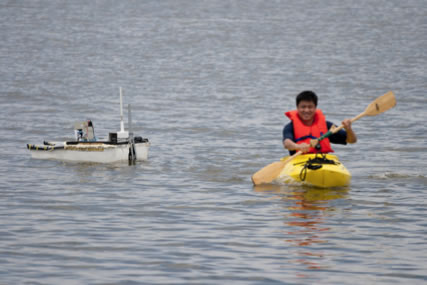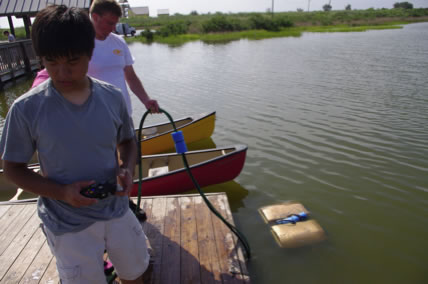
Robotic Surveys Help the Study of Weathered Crude Oil at Louisiana Coast One year after the Deepwater Horizon oil spill disaster, researchers are trying to pinpoint the remnants of the 200 million gallons of crude oil that leaked into the Gulf of Mexico. A multi-institution research group led by Prof. Fumin Zhang from the Georgia Tech School of Electrical and Computer Engineering recently performed a 20 day survey using student-developed marine robots at Grand Isle State Park in Louisiana, an area heavily polluted by crude oil that is still undergoing cleaning efforts. The field work was part of a collaboration between Profs. Zhang, Prof. Michael Malisoff from Louisiana State University, and Prof. Mark Patterson from the College of William and Mary that is supported by the National Science Foundation. The research goal is to develop robotic surveying methods to provide fast response to evaluate the immediate as well as longer term environmental impacts of the oil spill or future events of a similar nature. The Georgia Tech team developed an autonomous boat named Victoria that successfully performed autonomous surveys over a 300mx100m tidal lagoon in the park under various weather conditions. The robotic surveying methods provide a low cost and convenient way to collect data in marsh areas that are difficult to access by human based methods. Large amounts of data have been recorded from a crude oil sensor mounted on Victoria, which indicated an average concentration of suspicious carbon-hydrates at the level of 20-50 parts per billion. Such concentration, if confirmed to come from crude oil, is not considered acutely toxic to fish and wildlife, but may have long term negative effects that are yet to be understood. In addition to Victoria, the Georgia Tech team deployed a remotely operated underwater robot named ROV-Beta that collected water and sediments samples at spots where Victoria sensed high carbon-hydrate concentrations. The composition of the samples can be further analyzed to identify the species of the carbon-hydrates. The ROV-Beta demonstrated that it is able to collect the samples while keeping humans out of harm's way. An autonomous underwater vehicle, Fetch, developed by the College of William and Mary, performed autonomous surveys side by side with Victoria. Profs. Zhang, Malisoff, and Patterson have developed a control method that enabled Victoria and Fetch to synchronize their motion. Such cooperative behaviors involving different types of vehicles are essential building blocks for a large scale mobile sensor network to monitor and protect coastal areas. The Georgia Tech team have seen great contributions from graduate students Steven Bradshaw (ECE), Shayok Mukhopadhyay (ECE), and Chuanfeng Wang (ME), and undergraduate students Valerie Bazie (ECE), Phillip Cheng (ECE), Sean Maxon (ECE), and Brian Redden (ME). The full list of students who designed and built Victoria and ROV-Beta can be found at the Georgia Tech Savannah Robotics website, http://gtsr.gtsav.gatech.edu/.
|


